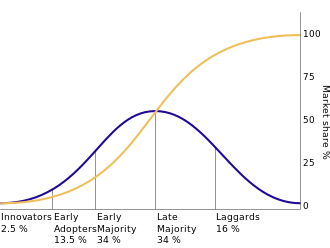This article needs additional citations for verification. (March 2023) |

Diffusion of innovations is a theory that seeks to explain how, why, and at what rate new ideas and technology spread. The theory was popularized by Everett Rogers in his book Diffusion of Innovations, first published in 1962.[1] Rogers argues that diffusion is the process by which an innovation is communicated through certain channels over time among the participants in a social system. The origins of the diffusion of innovations theory are varied and span multiple disciplines.
Rogers proposes that five main elements influence the spread of a new idea: the innovation itself, adopters, communication channels, time, and a social system. This process relies heavily on social capital. The innovation must be widely adopted in order to self-sustain. Within the rate of adoption, there is a point at which an innovation reaches critical mass. In 1989, management consultants working at the consulting firm Regis McKenna, Inc. theorized that this point lies at the boundary between the early adopters and the early majority. This gap between niche appeal and mass (self-sustained) adoption was originally labeled "the marketing chasm".[2]
The categories of adopters are innovators, early adopters, early majority, late majority, and laggards.[3] Diffusion manifests itself in different ways and is highly subject to the type of adopters and innovation-decision process. The criterion for the adopter categorization is innovativeness, defined as the degree to which an individual adopts a new idea.
- ^ Rogers, Everett (16 August 2003). Diffusion of Innovations, 5th Edition. Simon and Schuster. ISBN 978-0-7432-5823-4.
- ^ Schirtzinger, Warren (1989-08-22). "Crossing the Chasm Summary". High Tech Strategies. Retrieved 2022-07-19.
- ^ Rogers 1962, p. 150.